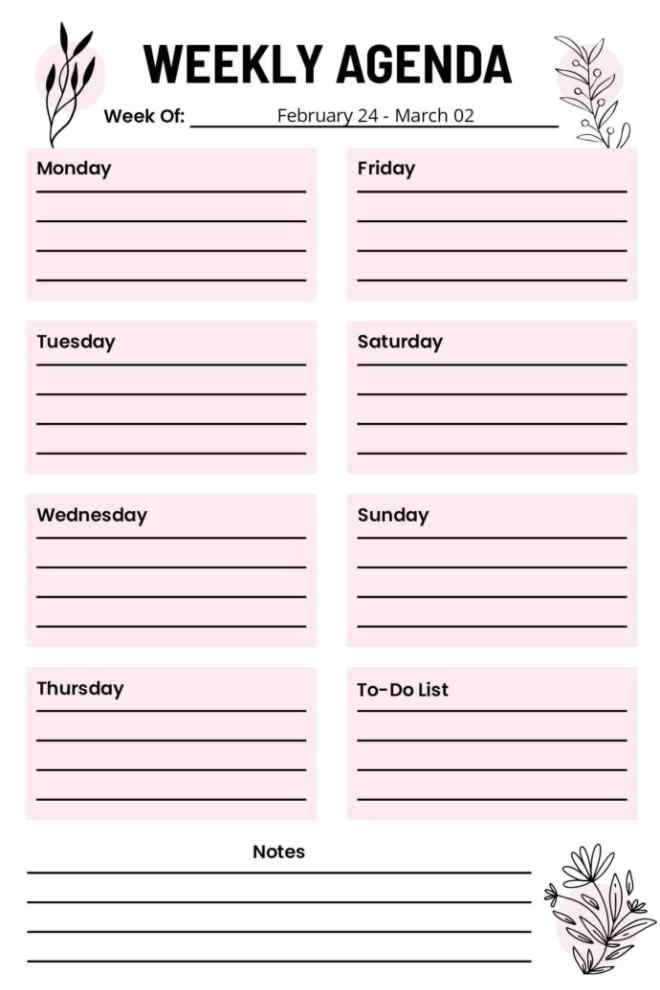Feeling overwhelmed by weekly tasks or struggling to meet deadlines? A well-structured weekly agenda planner template can help you stay focused, organized, and in control of your time. Whether you’re managing work, school, or personal goals, using a weekly schedule maker ensures everything is planned in one place.
Choose from a variety of printable planner template options, like printable weekly agenda formats or free agenda templates that suit your style and needs. With the right tools, you can create a clear routine, reduce stress, and improve productivity throughout the week.
A well-structured weekly agenda planner keeps you organized and on top of tasks. This elegant template features daily sections, a to-do list, and notes for a perfect balance of structure and flexibility. With soft pink accents and botanical elements, planning becomes both functional and visually appealing.
Stay on top of work, goals, and events with this customizable planner designed for any week. With a to-do list and notes section, it keeps priorities and reminders within reach. Explore our weekly planner template to find the perfect design for your needs!
Why Use a Weekly Agenda Planner? (With Visual Comparison)
An unplanned week can lead to missed deadlines, increased stress, and wasted time. In contrast, a structured weekly agenda planner helps you stay focused, manage your time wisely, and maintain a healthy balance between responsibilities. By setting clear goals and organizing your tasks in advance, you can reduce overwhelm and boost your overall productivity.
Visual Comparison: With vs. Without a Weekly Agenda Planner
| Aspect | Without a Planner | With a Planner |
|---|---|---|
| Task Management | Overwhelming and scattered | Clear priorities and structured tasks |
| Time Efficiency | Wasted due to indecision | Focused and productive throughout the week |
| Stress Levels | High from missed deadlines | Lower stress with better control |
| Goal Tracking | Difficult to measure or follow progress | Easy to track goals and reach milestones |
Using a weekly agenda planner not only brings clarity to your schedule but also supports long-term success by fostering consistency and intentional planning.
What Are the Different Types of Weekly Agenda Planners and How to Choose the Right One?
Depending on your lifestyle, you may need a different type of planner. Here’s a breakdown of three common types:
1. Work Agenda Planner
Best For: professionals, freelancers, entrepreneurs
- Organizes meetings, deadlines, and projects
A work planner provides a structured layout to manage meetings, schedule appointments, and track deadlines. It ensures you stay on top of important projects without missing key deliverables. Also, stay even more organized. you can manage meetings with a to-do list app that helps track tasks, set reminders, and prioritize your workload efficiently. - Tracks goals and progress
Many work planners include goal-setting pages where you can break down long-term objectives into smaller, actionable tasks. Progress-tracking sections help measure achievements and keep motivation high. - Includes sections for notes and reminders
With dedicated space for brainstorming, jotting down ideas, and setting reminders, a work planner prevents important details from slipping through the cracks. Also, feature priority lists to focus on urgent tasks first.
2. School Agenda Planner
Best For: Students, teachers, academic planners
- Tracks homework, exams, and assignments
A school planner helps students manage coursework by listing assignments, due dates, and exam schedules in an organized manner. Additionally, This ensures deadlines aren’t missed and last-minute cramming is minimized. - Schedules study sessions efficiently
By allocating specific time slots for studying different subjects, a study planner template enhances time management and prevents burnout. Some planners also include study progress trackers to monitor improvement. - Helps manage extracurricular activities
Whether it’s club meetings, sports practices, or volunteer work, a school planner helps balance academic and extracurricular commitments effectively. A weekly overview helps avoid scheduling conflicts.
3. Personal Agenda Planner
Best For: Individuals managing personal goals
- Plan week activities, workouts, and meal prep
A personal planner assists in organizing weekly routines, setting workout goals, and planning meals for the week. Some include grocery lists and nutrition trackers to simplify meal planning. - Helps track habits and self-care routines
Many personal planners feature habit trackers that encourage consistency in activities like reading, hydration, mindfulness, or exercise. Self-care sections help prioritize mental and physical well-being. - Organizes events and family schedules
From birthdays to appointments, a productivity planner template keeps track of social and family events. Shared planning options can help coordinate schedules with other household members for smoother day-to-day management.
Pro Tip: If you juggle multiple roles (e.g., student & part-time worker), try a hybrid planner with dedicated sections for each!
How Can You Use the Weekly Agenda Planner Template Effectively?
A planner is only effective if used efficiently. Follow these five steps to maximize your weekly planner: Choose a layout that fits your workflow, whether digital or paper. Keep it accessible to quickly jot down tasks and stay on track.
Set Weekly Goals
Start by defining what you want to accomplish by the end of the week. Having a clear vision helps you stay focused and motivated. Whether it’s a professional milestone, personal development goal, or household task, ultimately, setting specific objectives will make your week more productive and manageable.
- Completing a work project
- Studying for an exam
- Meal planning for the family
Assign Tasks to Each Week
Break your monthly goal into weekly tasks to stay organized and make consistent progress, organize your agenda with task prioritization by ensuring that essential objectives are completed first while still allowing flexibility for less critical ones.
- High Priority: Must be completed this week to stay on track.
- Medium Priority: Important but can be adjusted within the month.
- Low Priority: This can be postponed to another week if necessary.
Use Time Blocking
Use time blocking to structure your week efficiently, ensuring balance and reducing stress. This method allocates time for recurring tasks, preventing burnout. By planning ahead, you can stay productive while making space for personal time and relaxation.
Example Weekly Time Blocking Schedule:
| Day | Time Slot | Task |
|---|---|---|
| Monday | 8:00 AM – 10:00 AM | Work on Project A |
| Tuesday | 12:00 PM – 1:00 PM | Lunch & Relaxation |
| Wednesday | 3:00 PM – 4:00 PM | Gym session |
| Thursday | 10:00 AM – 12:00 PM | Study or Skill Development |
| Friday | 2:00 PM – 4:00 PM | Review Weekly Progress |
Keep It Flexible
Life is unpredictable, but flexibility in planning helps you stay on track. Leave buffer time between tasks to handle unexpected changes without stress. Balancing structure with adaptability ensures a smoother, more productive week.
Review & Adjust Weekly
Before a new week begins, reflect on what worked, what didn’t, and any challenges faced. Adjust your schedule and priorities based on these insights to improve efficiency. Regular reviews help you stay organized and boost productivity.
What Are Some Creative Ways to Personalize Your Weekly Agenda Planner Template?
Want to make your planner more engaging and effective? Adding personal touches can make planning more enjoyable and help you stay organized. Try these ideas to customize your planner to fit your lifestyle. For more inspiration, check out smart ways to organize your planner and discover creative strategies to maximize productivity.
🎨 Color Coding
Assign different colors for various categories to make your planner visually appealing and easy to navigate.
Examples:
- Work tasks – Blue (e.g., “Finish project report” in blue ink)
- Personal activities – Green (e.g., “Dinner with friends” in green ink)
- Deadlines & important events – Red (e.g., “Submit assignment by Friday” highlighted in red)
- Self-care & wellness – Purple (e.g., “Yoga at 6 PM” in purple ink)
Using a consistent color scheme makes it easier to identify priorities at a glance, keeping you on track.
📌 Sticky Notes & Symbols
Enhance your planner with sticky notes, stickers, and symbols to highlight key details and tasks.
Examples:
- Sticky notes for flexible or tentative tasks (e.g., “Call the client – may reschedule”)
- Stars for top priorities (e.g., ⭐ “Prepare for Monday’s meeting”)
- Exclamation marks for urgent deadlines (e.g., ❗“Pay electricity bill today”)
- Hearts or smiley faces to mark self-care moments (e.g., ❤️ “Spa day on Sunday”)
Visual cues make your planner more interactive, ensuring that important tasks stand out.
📅 Theme-Based Planner
Make planning fun by incorporating themes that reflect your personality or the season.
Examples:
- Seasonal themes – Winter Wonderland ❄️ (use cool colors, snowflake stickers), Summer Vibes ☀️ (bright colors, beach icons)
- Minimalist vs. Artistic Layouts – Clean and simple black-and-white designs or colorful, decorative pages with doodles
- Motivational Themes – Add a quote on each weekly page (e.g., “Success is the sum of small efforts repeated daily.”)
Customizing your planner’s look and feel can boost motivation and make organizing your week an enjoyable habit.
Conclusion
A weekly agenda planner helps you stay organized, reduce stress, and get things done on time. Whether you’re managing work, school, or personal tasks, having a clear plan makes life easier. Using the PlanWiz planner app can simplify your process by efficiently structuring your tasks.
FAQs
It’s a tool, either physical or digital, designed to organize your tasks, appointments, and goals on a week-by-week basis, providing a clear overview of your upcoming schedule.
Utilizing a weekly planner enhances organization, improves time management, reduces feelings of being overwhelmed, increases productivity by focusing efforts, and helps track progress toward objectives.
By providing a structured view of your commitments, a planner helps you anticipate deadlines, allocate time effectively, and avoid last-minute rushes, leading to a greater sense of control and reduced anxiety.
You can personalize your planner using stickers, different colored pens, washi tape, and by creating visual cues or symbols for recurring tasks or important events.
A weekly agenda planner template allows you to prioritize tasks, schedule dedicated time for important activities, and minimize distractions by having a clear roadmap of what needs to be done.








